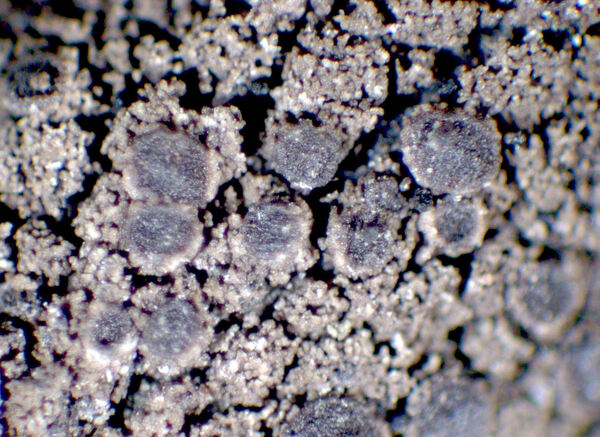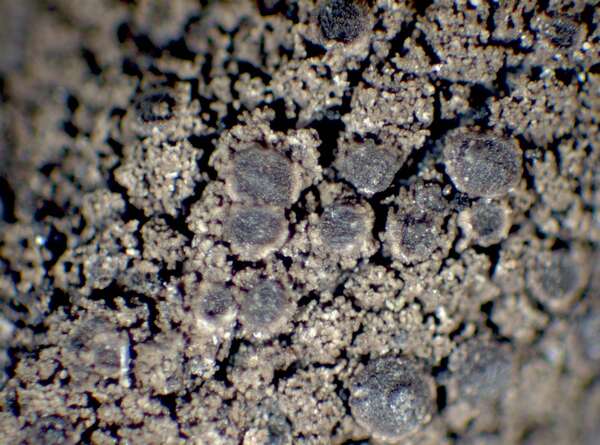Rinodina malangica (Norman) Arnold
Flora, 64: 196, 1881. Basionym: Rinodina leprosa subsp. malangica Norman - K. Norske Vid. Selsk. Skr., 5: 342, 1868.
Synonyms: Rinodina pyrina f. rhododendri ("Hepp") Arnold; Rinodina rhododendri Hepp ex H. Magn.; Rinodina sophodes var. malangica (Norman) Th. Fr.
Distribution: N - Frl, TAA (Nascimbene & al. 2007b, Nascimbene & al. 2022), Piem (Tretiach 1997).
Description: Thallus crustose-subsquamulose, episubstratic, well developed, yellowish brown, olivaceous, grey-brown or grey-green, of contiguous, sublobate areoles/squamules more or less entirely covered in coralloid, (30-)50-60 µm thick blastidia. Apothecia lecanorine, immersed, scattered, (0.2-)0.5-0.8 mm across, with a mostly persistently flat, brown disc, and a thick, usually blastidiate thalline margin. Thalline exciple 80-100 µm wide laterally, cellular, with a thin, indistinct cortex; proper exciple 10-15 µm wide laterally, expanded to 30-35 µm in upper part; epithecium reddish brown, K-; hymenium colourless, 70-90 µm high; paraphyses 2-2.5 µm thick at mid-level, the apical cells up to 5 µm wide; hypothecium colourless, 50-100 µm high. Asci 8-spored, clavate, the K/I+ blue tholus penetrated by a faintly amyloid apical cushion with parallel or diverging flanks, the wall K/I-, surrounded by a K/I+ blue outer layer, Lecanora-type. Ascospores 1-septate, not constricted at septum, brown, ellipsoid, 13-18 x 6-9 µm, with a well-developed torus and smooth walls, Physcia-type, the ontogeny of type A (apical wall thickening after the early septum formation). Photobiont chlorococcoid. Spot tests: K-, C-, KC-, P-, UV-. Chemistry: without lichen substances. Note: a species known from the central European mountains, the Pyrenees, Norway and the Canary Islands, found on shrubs (often on Rhododendron) in the subalpine belt, especially on the basal parts of stems, where it can be very abundant, sometimes on lignum; probably widespread throughout the Alps.
Growth form: Crustose
Substrata: bark
Photobiont: green algae other than Trentepohlia
Reproductive strategy: mainly asexual, by soredia, or soredia-like structures (e.g. blastidia)
Commonnes-rarity: (info)
Alpine belt: absent
Subalpine belt: rather common
Oromediterranean belt: absent
Montane belt: extremely rare
Submediterranean belt: absent
Padanian area: absent
Humid submediterranean belt: absent
Humid mediterranean belt: absent
Dry mediterranean belt: absent

Predictive model
Herbarium samples
Growth form: Crustose
Substrata: bark
Photobiont: green algae other than Trentepohlia
Reproductive strategy: mainly asexual, by soredia, or soredia-like structures (e.g. blastidia)
Commonnes-rarity: (info)
Alpine belt: absent
Subalpine belt: rather common
Oromediterranean belt: absent
Montane belt: extremely rare
Submediterranean belt: absent
Padanian area: absent
Humid submediterranean belt: absent
Humid mediterranean belt: absent
Dry mediterranean belt: absent

Predictive model
| Herbarium samples |
 INDEX FUNGORUM
INDEX FUNGORUM
 GBIF
GBIF
 DOLICHENS
DOLICHENS






